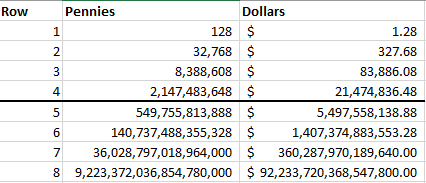Using the data from https://covidtracking.com/data/national/cases: in the most recent seven day span (10-16 November), 1,056,346 people in the US have been infected with this coronavirus. The total number of cases yesterday was 11,047,064. That means 9.562% of the *total cases* in the US were new cases in the past week.
This is how exponential growth works — and why you heard a lot about ‘flattening the curve’ earlier in the year. If you put a penny on the first square of a chess board, double it and put two pennies on the second square, double it and put four pennies on the third square, and continue in that fashion … mathematically, you have 2^n pennies on each square, where n is the numeric sequence of the square, 0-63. On the last square in the first row, square #7, there are 2^7 pennies — 128 pennies, or a buck and twenty eight cents. Not a lot. And the end of the second row, you have 2^15 pennies — 32,768 pennies. That’s $327.68 — over three hundred bucks. A lot more than a buck, but not a huge amount of money. But you’re up to 2^23 at the end of the third row — 8,388,608 pennies or $83,886.08. Eighty three grand is a lot of money. By the time you get to the mid-point on the board, the end of the fourth row, you have 2^31 pennies on a square. 2,147,483,648 pennies for $21,474,836.48 — over twenty million dollars. A lot of money, but it’s possible. The second half of the chessboard is where exponential growth becomes unsustainable. The end of the fifth row is 2^39 — 549,755,813,888 pennies. The end of the sixth row is 2^47 — 140,737,488,355,328 pennies. The end of the seventh row is 2^55 — On the final square, you have 2^63 … 9,223,372,036,854,775,808 pennies for $92,233,720,368,547,758.08 … 92 quadrillion dollars. If the going price of Earth is only five quadrillion dollars, you’re putting a marker for the entire solar system (and then some) on that last square.
And that ignores the accumulating total — while you have 92 quadrillion dollars on the final square, you have another 92 quadrillion dollars on the entire rest of the board. Now, obviously, we are not doubling our rate of infections every day. But we’re entering “second half of the board” territory just the same.
